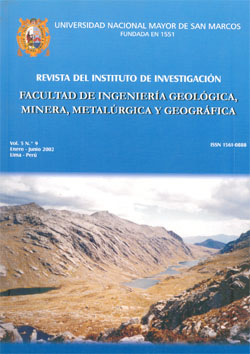Carbothermic reduction of metal sulfides
DOI:
https://doi.org/10.15381/iigeo.v5i9.666Keywords:
carbothermic reduction, metal sulfides, calcium carbonate.Abstract
Various non-ferrous metals such as copper, zinc, lead, molybdenum, nickel, cobalt, antimony, etc.. are produced mainly from metal sulfides. Conventional pyrometallurgical methods of treatment of sulfide concentrates for the production of metals include one or more stages of oxidation of these sulfides. During the course of oxidation occurs inevitably the formation of gaseous SO2, which causes serious problems of environmental pollution since it is rarely feasible, since the economic standpoint, swing it completely and a significant portion of the gas escapes to always atmosphere either as a gas fireplace or fugitives gas. Additionally, traditional pyrometallurgical methods are not suitable for treating most of these metal sulfides when they are in the form of low grade concentrates, or when they are small mineral deposits forming or polymetallic sulphide deposits. This is mainly due to complex flow diagrams treatment or high cost of investment followed by the high cost of abatement of SO2 gas pyrometallurgical produced in these methods. An alternative method for treating sulfide concentrates to avoid air pollution with SO2 is the direct reduction of metal sulfide gas reducers or reducing solids [1-10]. An attractive alternative, explored in a limited way, is the carbothermal reduction of sulfur in the presence of a sulfur scavenger [3,4,6,10, 11]. This interesting alternative is the topic to be discussed in this paper.
Downloads
Published
Issue
Section
License
Copyright (c) 2002 Rafael Padilla

This work is licensed under a Creative Commons Attribution-NonCommercial-ShareAlike 4.0 International License.
AUTHORS RETAIN THEIR RIGHTS:
a. Authors retain their trade mark rights and patent, and also on any process or procedure described in the article.
b. Authors retain their right to share, copy, distribute, perform and publicly communicate their article (eg, to place their article in an institutional repository or publish it in a book), with an acknowledgment of its initial publication in the Rev. Inst. investig. Fac. minas metal cienc. geogr.
c. Authors retain theirs right to make a subsequent publication of their work, to use the article or any part thereof (eg a compilation of his papers, lecture notes, thesis, or a book), always indicating the source of publication (the originator of the work, journal, volume, number and date).






